"Cool story", or why liquid helium could not make a revolution in the dispersal?
Hi, Giktayms! The overclocking of iron in the home PC is an improved air cooling, the chips selected by the manufacturer and, preferably, the flashy lighting of the components (+80 to overclocking). “Sports” overclocking at competitions is almost always liquid nitrogen and a modification of the iron supply system. Where are all the alternatives and what they were - we understand today.
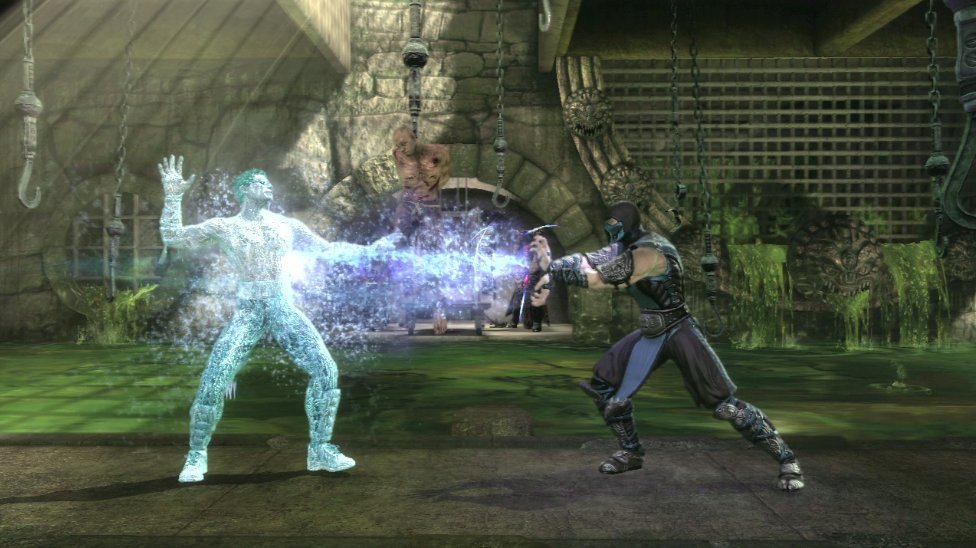
What prevents professional sports from becoming amusing and entertaining, like pokatushki "Mad Max"? Regulations! “Equalization” applies to the clothes of athletes, and the characteristics of the equipment, and many, many other little things - to ensure safety and more or less equal conditions of competition (instead of the competition of “wallets”). And some decisions are also discarded by the participants of the championships themselves, because a step to the right, a step to the left is a lost podium. Otherwise, we would have seen a lot of hilarious finds in the same "Formula 1" , for example.
')
But what the matter is - in overclocking there are no strict restrictions on the types of iron cooling. In the so-called “offline championships” the enthusiast is free to cool the computer with all available methods for the sake of maximum results. Why then the world championship table is not filled with records using liquid helium? Where have fashionable and efficient refrigerators “on freon” disappeared? Why is thermoelectric cooling turned utopia? And how did it happen that the sweetheart heart “dropsy” (liquid cooling system) today has become suitable only for “civilian PCs”? We find out in what conditions lived-lived, and why the outlandish cooling systems died out.
“All the melodies are sung, the verses are all written,” everything is dispersed with nitrogen, but helium is meaningless. A strange situation comes out, because it was liquid helium that was supposed to become a symbol of a new era of overclocking. With his help, in theory, it would be possible to rewrite the world records table for overclocking in a new way. But this type of cooling was marginal as it was.
And it's not about technical limitations - liquid helium boils right at -269 degrees Celsius, while nitrogen capitulates already at -196 ° C. That is, with helium it is possible to “pile” parrots in benchmarks where the nitrogen potential is no longer enough. In theory.
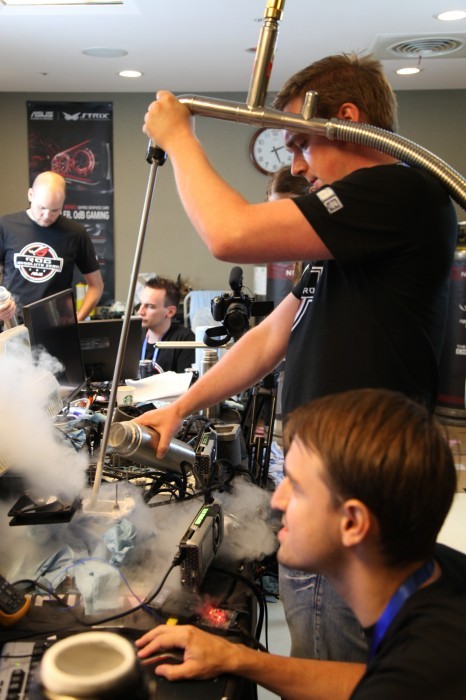
Dancop and Smoke at the ASUS Extrem Abs Absolute Zero event - overclocking Intel Core i7-6700K with liquid helium
In fact, overclockers around the world are avoiding helium, and for a couple of good reasons. Let us forget for a moment about the “zestasim” and costly selection of components that do not show coldbug (coldbug - temperature threshold, below which the iron refuses to work) at temperatures characteristic of helium. In the end, overclocker must be a maximalist.
The main obstacle is the price of the issue. One liter of liquid helium will cost 15–20 times more expensive than the same amount of liquid nitrogen, while for intensive cooling of helium, it is always needed 4 times more. In an interview with Smoke overclocker, we mentioned specific numbers - 200 liters of helium worth 20 thousand dollars per half hour of the benchmark versus $ 65-110 in the case of nitrogen. One million and two hundred thousand rubles in order to "break up the glands" once!
Already for this reason, acceleration with the help of helium has become a rare ritual, which is held on sponsorship money. Most often, such events are sponsored by AMD, with the filing of which the history of overclocking with helium began, or ASUS ROG, which thus loudly announces the potential of its motherboards.
Liquid helium became a powerful advertising tool for AMD - when, at CES 2009, the “red camp” decided to squeeze the maximum out of the processors, SF3D and Sampsa overclockers got at the disposal of helium with a total value of about $ 40,000. However, there are rumors that for the sake of cost savings, enthusiasts even came to the supplier of helium for medical institutions and bargained for a more humane amount. But the final 6301 MHz on the Phenom II X4 attracted general attention. At the same time, in July, the Phenom II X4 955 Black Edition removed the neoforce , DeDaL , DoNNy and pofigist guys on the international team to 7 GHz. And they looked even better at 8429 MHz in the FX-8150 processor a couple of years later.
Until recent times, the atmosphere of AMD on AMD and AMD drives in the overclocking records with the use of helium - simply because the “red” chips themselves are a little hotter and they tolerate the extremely low temperature better, and they are well scaled by temperature and voltage. Until recently, overclocking Intel chips lacked liquid nitrogen.
Why, at maximum efficiency, liquid helium is not used to disperse another type of iron? Because modern RAM does not need negative temperatures for maximum speed - overclockers, on the contrary, heat it up with a hair dryer so that RAM works in standard mode and not “frozen” like a processor.
But when overclocking video cards with helium, the video memory is “the weakest link”. Because if video chips tolerate extreme cooling well, then GDDR5 / GDDR5X does not like temperatures typical for helium. With the spread of HBM memory, the situation will only get worse. In addition, the current generation NVIDIA Pascal video cards (“thousandth” series) reveal their potential at much less severe temperatures - they simply do not need liquid helium in order to “go all the money”.
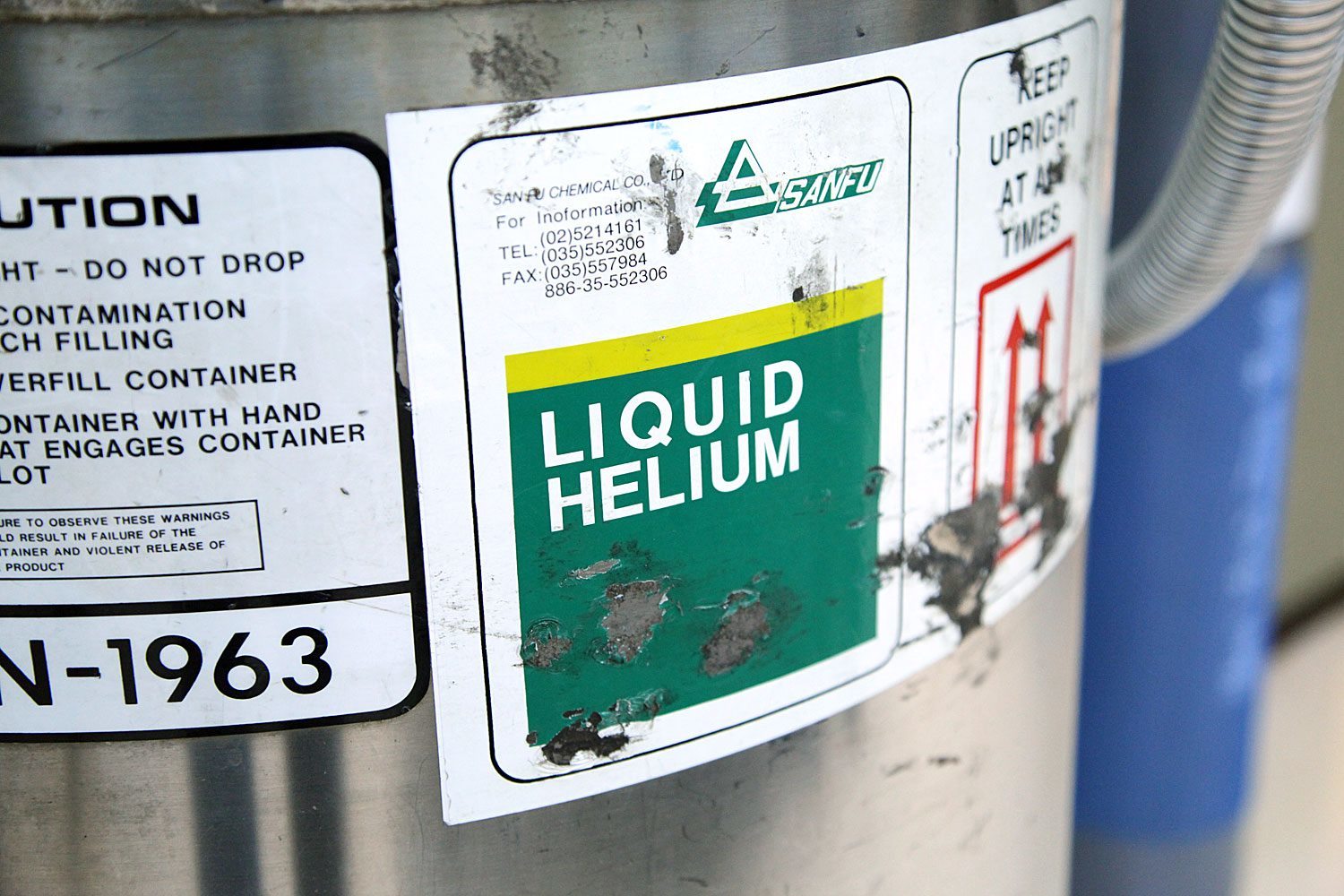
Even transporting liquid helium and finding room for a bench session is problematic.
And even at the very acceleration of processors at ultra-low temperatures, new "jokes" appear. If the processor is cooled too quickly, the pins (legs) become covered with ice and lose contact in the socket. That is, the processor instantly hangs.
Nobody has canceled retro-blocking on components that are more resistant to freezing, and overclocking fans could set new records on the old hardware. But the support of manufacturers in professional overclocking is always associated with advertising new products in the industry - no one wants to do advertising and invest in bench sessions with video cards and processors of the past years.
Acceleration problems with the use of liquid helium continue even at the organizational level. Even if you find a supplier and agree on a price, you need to rent a giant Dewar vessel, find a well-ventilated room (helium evaporates instantly and leaves a huge amount of condensate behind - 3 times more than liquid nitrogen). The helium acceleration procedure itself is also fraught with troubles, since it begins with ... nitrogen acceleration. Copper "glass" for heat removal is first cooled to -196 degrees Celsius, and only then liquid helium is fed through the capillary. And not in the “nonstop” mode, but in portions, so that the overclocker has the ability to control the stability of the system.
The helium cooling technique is designed so that the enthusiast has about 10 seconds to run the test and the result, after which it will be necessary to try again. This is one of the reasons why such cooling is not used for video cards - graphic tests are not so short. Now helium helps to produce record results except in the disciplines SuperPi 1M, PiFast, HWBot Prime and, to a lesser extent, Cinebench.
Overclocking AMD and Intel processors with liquid helium is “two big differences”. In the case of AMD and its prohibitively high frequencies, we are more likely talking about the so-called validation - the maximum possible processor frequency without thinking about whether it gives an increase in benchmarks, or not. The overclocking of new Intel architectures is more complicated, but it is effective and it is precisely with it that new achievements in benchmarks are associated. By the way, expect world records for the authorship of Russian overs in January, when the embargo on the publication of reviews of new Core i7 Kaby Lake will be lifted :)
Acceleration with the help of helium, for all its high cost and cooling efficiency, is by no means a “cheat”, but it is not a guarantor of records. For example, helium has not yet occupied the top of tournament tables in overclocking. Now he is, rather, an instrument for "extreme measures", when the organizers have a guarantee that the iron will be able to produce results at ultra low temperatures in a short time.
Are there "unconventional" ways of cooling components? Of course, yes, but almost all of them are pulling, perhaps, against self-indulgence compared to the potential of liquid nitrogen.
For example, cooling using thermoelectric plates, or, in other words, Peltier elements . These are the analogs of the “thermal pump”: with one side, which absorbs heat, and the other, which emits it. That is, a similar element is able to take on the heat that the processor emits, and transfer it to the radiator, which is already cooling the processor cooler.
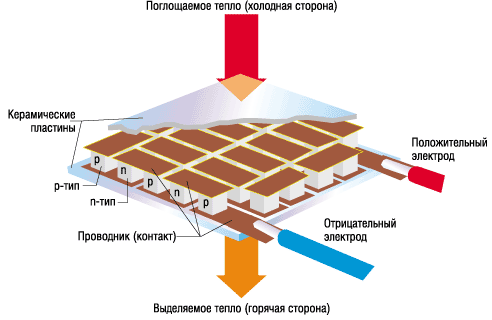
Peltier Module Design
By itself, this cooling option is curious, which, due to its low efficiency and high energy consumption, remained poorly distributed. Today, Peltier modules are most often used to cool or heat components with a modest TDP. Overclockers often simply reverse the polarity and use modules ... to warm up the video memory. And then, as we mentioned above, this problem is usually handled by an ordinary industrial hairdryer. Moreover, in some overclocking video cards, the memory heating is implemented by the manufacturer itself.
But the so-called " chiller ", although it does not beat performance records, is still common and loved by overclockers. A chiller is a system similar to an industrial aquarium, only for cooling iron. I mean, freon, with refrigerant, and liquid - with water blocks. The compressor compresses the freon, and then converts it into a liquid form, cools and pumps it through the water blocks.
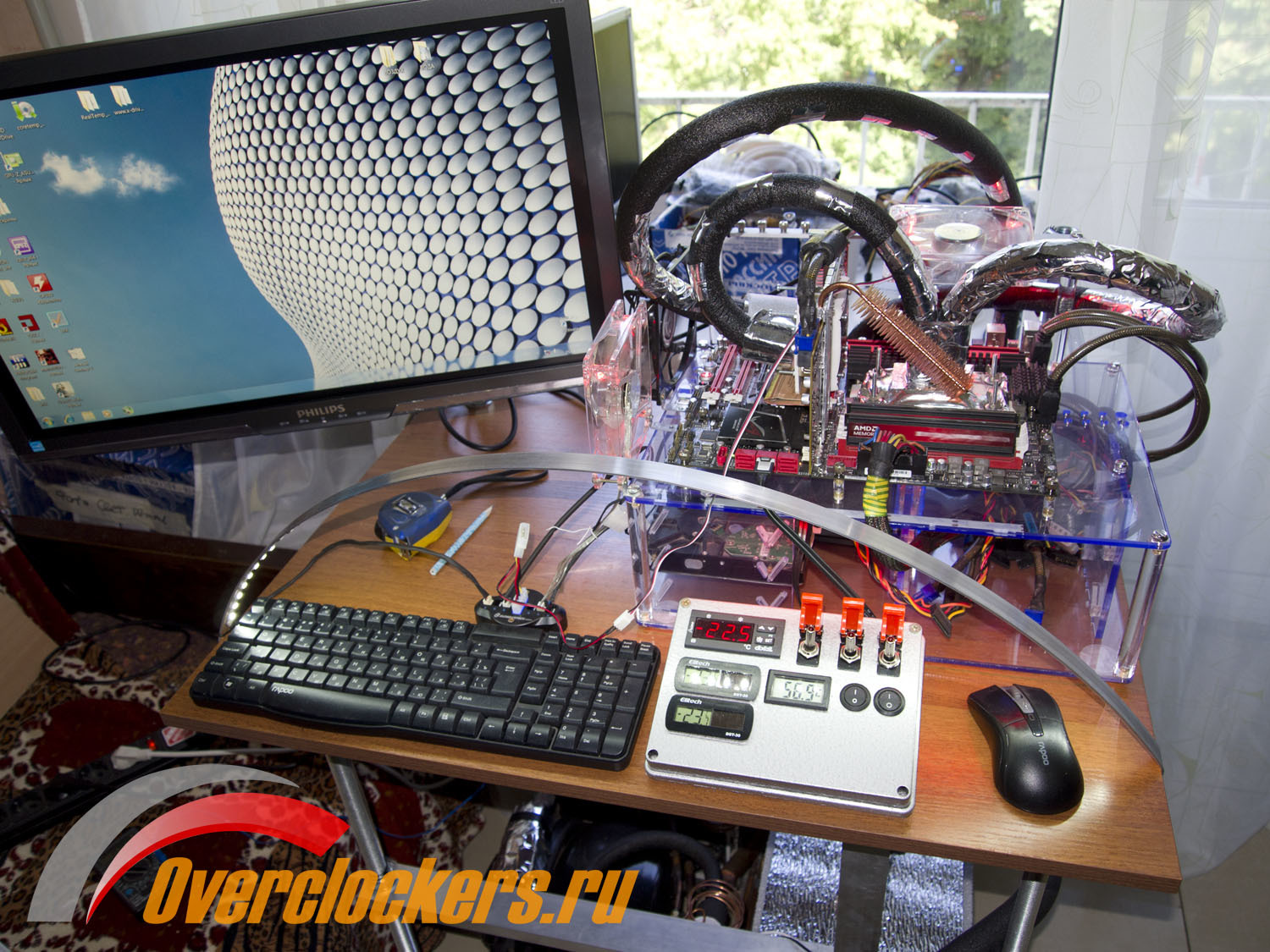
Homemade chiller (photo: overclockers.ru )
Unlike conventional water cooling, it maintains not room temperature, but “near zero” temperature, or even allows you to slightly go “in minus”. Very noisy, but reliable design, which and maintenance is not really required. It is great for overclocking at home, not used in professional overclocking, because for competitions today we need to achieve much lower temperatures.
Dry ice was once a very efficient and affordable method of overclocking - it was used at full speed during the days of the Intel Sandy Bridge architecture. However, today it is needed to very few people, since it is applicable in processors that require cooling to -75 degrees Celsius. That is, it is more likely to be used for amateur purposes.

Dry ice
But chillers based on a phase transition system are still viable and efficient. The simplest version of such a system is Single Stage (“Freon”, as they say). It is a single-stage chiller - something like an air conditioner. The compressor compresses the refrigerant, which is heated by this procedure. Then the refrigerant enters the condenser, loses its temperature and becomes liquid, after which it passes through the filter drier and returns to the compressor in the form of steam. This is enough to cool the processor to -60 degrees Celsius. For more impressive results, you need to cool the condenser of the Single Stage system with another “Freon” (so that you can cool the freon while you cool the freon). According to the law, "grandma for grandpa, grandpa for turnips" and cascade systems are constructed.
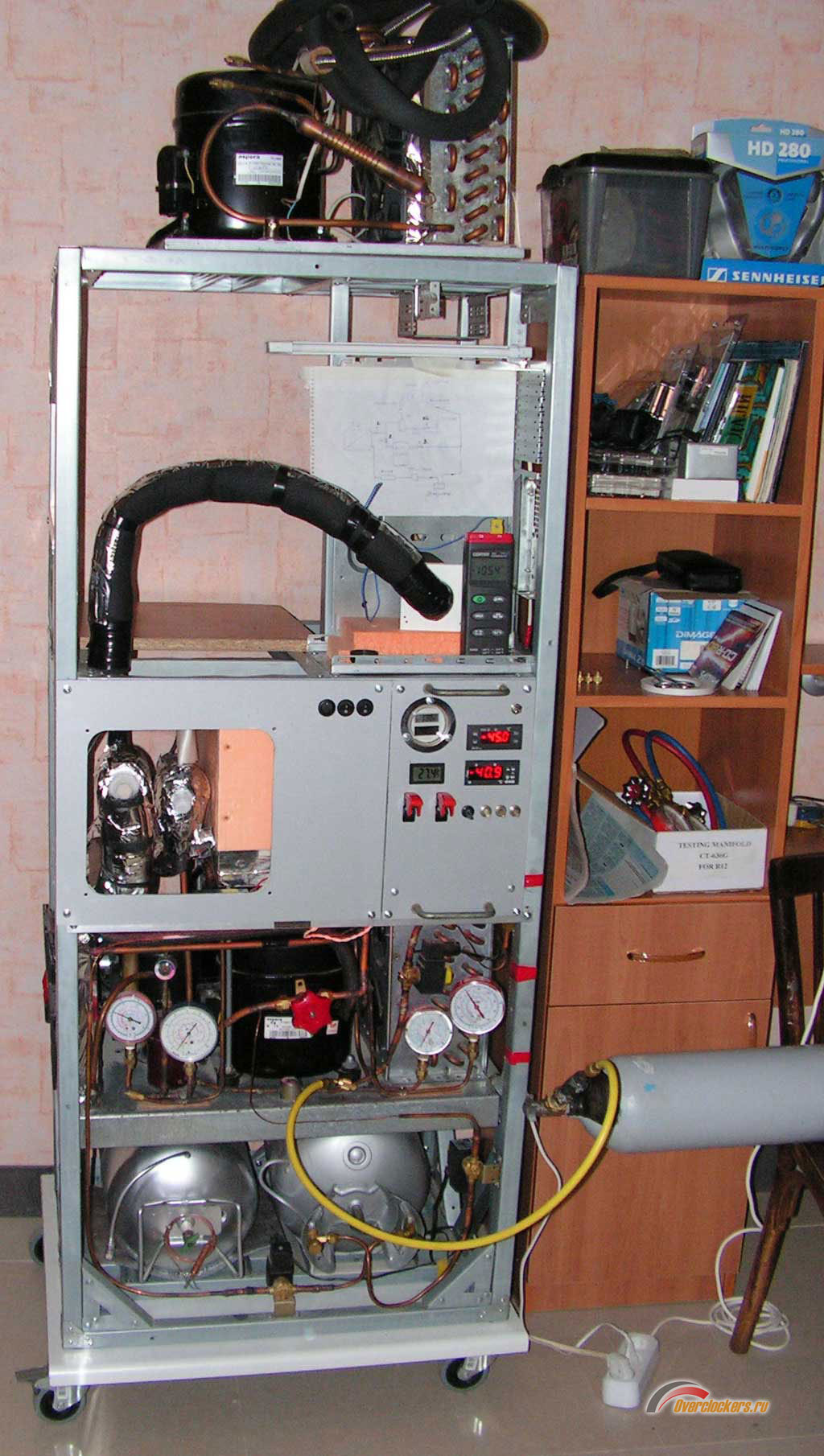
Cascade refrigeration system (photo: overclockers.ru )
They are good in reliability and, in case of long-term operation, they make it possible to forget about purchasing liquid nitrogen at all. They can provide cooling comparable to this very nitrogen (for such systems there are no unattainable temperatures — there are few stages in the cascade), but such systems have lost almost all of their popularity.
Why? Firstly, due to the cumbersome design - to build a system comparable in efficiency to cooling with nitrogen, you will need an impressive room size. Secondly, the power consumption of cascade systems goes beyond all reasonable limits - such overclocking can easily burn the wiring in the living room. But these are the very “hardcore” systems that the public lacks, indifferent to liquid nitrogen and its special effects.
In overclocking, there is no “ultimatum-best” way of cooling - “pops” in the face of liquid nitrogen has just become the lesser of the evils among their own kind. Nitrogen covers the temperature limits of most modern processors, cheap in operation and allows you to achieve a result with less effort. More steep, in theory, liquid helium gives an increase only in some scenarios and costs incomparably more expensive, and alternative cooling systems are either not efficient enough or they are too expensive. That is why modern overclocking in its stereotypical sense is associated with a guy armed with a glass with nitrogen inside. But the right word, as long as we see new records, there is nothing wrong with that.
Ladies and gentlemen, Captain Obviously reports that "The New Year is rushing to us - soon everything will happen." Many thanks to all who read and comment us! And in order for the computer to bring more joy in the new year than in the old one, we have prepared discounts for hardware and Kingston / HyperX accessories. Starring:
- 12% discount on DDR4 Predator memory on the Ulmart network. You are arming with the promotional code GEEKPR16 - and by December 31, 2016 you get the opportunity to buy the flagship “RAM” cheaper.
- want even cheaper? Do not miss the Savage DDR3 / DDR4 10% discount and HyperX Savage solid state drives. Promotional code SAVAGE16 in the Ulmart network is valid until December 28, 2016 .
- memory is even cheaper even where it is initially inexpensive. Up to December 28, with the KING16 promo code on the Ulmart network , a 10% discount on Kingston ValueRAM RAM!
Happy all! Subscribe and stay with us - it will be interesting! For more information about Kingston and HyperX products, visit the company's official website . In choosing your kit HyperX help page with visual aids .

What prevents professional sports from becoming amusing and entertaining, like pokatushki "Mad Max"? Regulations! “Equalization” applies to the clothes of athletes, and the characteristics of the equipment, and many, many other little things - to ensure safety and more or less equal conditions of competition (instead of the competition of “wallets”). And some decisions are also discarded by the participants of the championships themselves, because a step to the right, a step to the left is a lost podium. Otherwise, we would have seen a lot of hilarious finds in the same "Formula 1" , for example.
')
But what the matter is - in overclocking there are no strict restrictions on the types of iron cooling. In the so-called “offline championships” the enthusiast is free to cool the computer with all available methods for the sake of maximum results. Why then the world championship table is not filled with records using liquid helium? Where have fashionable and efficient refrigerators “on freon” disappeared? Why is thermoelectric cooling turned utopia? And how did it happen that the sweetheart heart “dropsy” (liquid cooling system) today has become suitable only for “civilian PCs”? We find out in what conditions lived-lived, and why the outlandish cooling systems died out.
Millions of rubles for acceleration of iron
“All the melodies are sung, the verses are all written,” everything is dispersed with nitrogen, but helium is meaningless. A strange situation comes out, because it was liquid helium that was supposed to become a symbol of a new era of overclocking. With his help, in theory, it would be possible to rewrite the world records table for overclocking in a new way. But this type of cooling was marginal as it was.
And it's not about technical limitations - liquid helium boils right at -269 degrees Celsius, while nitrogen capitulates already at -196 ° C. That is, with helium it is possible to “pile” parrots in benchmarks where the nitrogen potential is no longer enough. In theory.

Dancop and Smoke at the ASUS Extrem Abs Absolute Zero event - overclocking Intel Core i7-6700K with liquid helium
In fact, overclockers around the world are avoiding helium, and for a couple of good reasons. Let us forget for a moment about the “zestasim” and costly selection of components that do not show coldbug (coldbug - temperature threshold, below which the iron refuses to work) at temperatures characteristic of helium. In the end, overclocker must be a maximalist.
The main obstacle is the price of the issue. One liter of liquid helium will cost 15–20 times more expensive than the same amount of liquid nitrogen, while for intensive cooling of helium, it is always needed 4 times more. In an interview with Smoke overclocker, we mentioned specific numbers - 200 liters of helium worth 20 thousand dollars per half hour of the benchmark versus $ 65-110 in the case of nitrogen. One million and two hundred thousand rubles in order to "break up the glands" once!
Already for this reason, acceleration with the help of helium has become a rare ritual, which is held on sponsorship money. Most often, such events are sponsored by AMD, with the filing of which the history of overclocking with helium began, or ASUS ROG, which thus loudly announces the potential of its motherboards.
The most effective and most problematic overclocking
Liquid helium became a powerful advertising tool for AMD - when, at CES 2009, the “red camp” decided to squeeze the maximum out of the processors, SF3D and Sampsa overclockers got at the disposal of helium with a total value of about $ 40,000. However, there are rumors that for the sake of cost savings, enthusiasts even came to the supplier of helium for medical institutions and bargained for a more humane amount. But the final 6301 MHz on the Phenom II X4 attracted general attention. At the same time, in July, the Phenom II X4 955 Black Edition removed the neoforce , DeDaL , DoNNy and pofigist guys on the international team to 7 GHz. And they looked even better at 8429 MHz in the FX-8150 processor a couple of years later.
Until recent times, the atmosphere of AMD on AMD and AMD drives in the overclocking records with the use of helium - simply because the “red” chips themselves are a little hotter and they tolerate the extremely low temperature better, and they are well scaled by temperature and voltage. Until recently, overclocking Intel chips lacked liquid nitrogen.
Why, at maximum efficiency, liquid helium is not used to disperse another type of iron? Because modern RAM does not need negative temperatures for maximum speed - overclockers, on the contrary, heat it up with a hair dryer so that RAM works in standard mode and not “frozen” like a processor.
But when overclocking video cards with helium, the video memory is “the weakest link”. Because if video chips tolerate extreme cooling well, then GDDR5 / GDDR5X does not like temperatures typical for helium. With the spread of HBM memory, the situation will only get worse. In addition, the current generation NVIDIA Pascal video cards (“thousandth” series) reveal their potential at much less severe temperatures - they simply do not need liquid helium in order to “go all the money”.

Even transporting liquid helium and finding room for a bench session is problematic.
And even at the very acceleration of processors at ultra-low temperatures, new "jokes" appear. If the processor is cooled too quickly, the pins (legs) become covered with ice and lose contact in the socket. That is, the processor instantly hangs.
Nobody has canceled retro-blocking on components that are more resistant to freezing, and overclocking fans could set new records on the old hardware. But the support of manufacturers in professional overclocking is always associated with advertising new products in the industry - no one wants to do advertising and invest in bench sessions with video cards and processors of the past years.
Ten seconds to world record
Acceleration problems with the use of liquid helium continue even at the organizational level. Even if you find a supplier and agree on a price, you need to rent a giant Dewar vessel, find a well-ventilated room (helium evaporates instantly and leaves a huge amount of condensate behind - 3 times more than liquid nitrogen). The helium acceleration procedure itself is also fraught with troubles, since it begins with ... nitrogen acceleration. Copper "glass" for heat removal is first cooled to -196 degrees Celsius, and only then liquid helium is fed through the capillary. And not in the “nonstop” mode, but in portions, so that the overclocker has the ability to control the stability of the system.
The helium cooling technique is designed so that the enthusiast has about 10 seconds to run the test and the result, after which it will be necessary to try again. This is one of the reasons why such cooling is not used for video cards - graphic tests are not so short. Now helium helps to produce record results except in the disciplines SuperPi 1M, PiFast, HWBot Prime and, to a lesser extent, Cinebench.
Do you need frequency or effectiveness?
Overclocking AMD and Intel processors with liquid helium is “two big differences”. In the case of AMD and its prohibitively high frequencies, we are more likely talking about the so-called validation - the maximum possible processor frequency without thinking about whether it gives an increase in benchmarks, or not. The overclocking of new Intel architectures is more complicated, but it is effective and it is precisely with it that new achievements in benchmarks are associated. By the way, expect world records for the authorship of Russian overs in January, when the embargo on the publication of reviews of new Core i7 Kaby Lake will be lifted :)
Acceleration with the help of helium, for all its high cost and cooling efficiency, is by no means a “cheat”, but it is not a guarantor of records. For example, helium has not yet occupied the top of tournament tables in overclocking. Now he is, rather, an instrument for "extreme measures", when the organizers have a guarantee that the iron will be able to produce results at ultra low temperatures in a short time.
Alternatives to nitrogen and helium in overclocking
Are there "unconventional" ways of cooling components? Of course, yes, but almost all of them are pulling, perhaps, against self-indulgence compared to the potential of liquid nitrogen.
For example, cooling using thermoelectric plates, or, in other words, Peltier elements . These are the analogs of the “thermal pump”: with one side, which absorbs heat, and the other, which emits it. That is, a similar element is able to take on the heat that the processor emits, and transfer it to the radiator, which is already cooling the processor cooler.

Peltier Module Design
By itself, this cooling option is curious, which, due to its low efficiency and high energy consumption, remained poorly distributed. Today, Peltier modules are most often used to cool or heat components with a modest TDP. Overclockers often simply reverse the polarity and use modules ... to warm up the video memory. And then, as we mentioned above, this problem is usually handled by an ordinary industrial hairdryer. Moreover, in some overclocking video cards, the memory heating is implemented by the manufacturer itself.
But the so-called " chiller ", although it does not beat performance records, is still common and loved by overclockers. A chiller is a system similar to an industrial aquarium, only for cooling iron. I mean, freon, with refrigerant, and liquid - with water blocks. The compressor compresses the freon, and then converts it into a liquid form, cools and pumps it through the water blocks.

Homemade chiller (photo: overclockers.ru )
Unlike conventional water cooling, it maintains not room temperature, but “near zero” temperature, or even allows you to slightly go “in minus”. Very noisy, but reliable design, which and maintenance is not really required. It is great for overclocking at home, not used in professional overclocking, because for competitions today we need to achieve much lower temperatures.
Dry ice was once a very efficient and affordable method of overclocking - it was used at full speed during the days of the Intel Sandy Bridge architecture. However, today it is needed to very few people, since it is applicable in processors that require cooling to -75 degrees Celsius. That is, it is more likely to be used for amateur purposes.

Dry ice
But chillers based on a phase transition system are still viable and efficient. The simplest version of such a system is Single Stage (“Freon”, as they say). It is a single-stage chiller - something like an air conditioner. The compressor compresses the refrigerant, which is heated by this procedure. Then the refrigerant enters the condenser, loses its temperature and becomes liquid, after which it passes through the filter drier and returns to the compressor in the form of steam. This is enough to cool the processor to -60 degrees Celsius. For more impressive results, you need to cool the condenser of the Single Stage system with another “Freon” (so that you can cool the freon while you cool the freon). According to the law, "grandma for grandpa, grandpa for turnips" and cascade systems are constructed.

Cascade refrigeration system (photo: overclockers.ru )
They are good in reliability and, in case of long-term operation, they make it possible to forget about purchasing liquid nitrogen at all. They can provide cooling comparable to this very nitrogen (for such systems there are no unattainable temperatures — there are few stages in the cascade), but such systems have lost almost all of their popularity.
Why? Firstly, due to the cumbersome design - to build a system comparable in efficiency to cooling with nitrogen, you will need an impressive room size. Secondly, the power consumption of cascade systems goes beyond all reasonable limits - such overclocking can easily burn the wiring in the living room. But these are the very “hardcore” systems that the public lacks, indifferent to liquid nitrogen and its special effects.
No need to reinvent the wheel
In overclocking, there is no “ultimatum-best” way of cooling - “pops” in the face of liquid nitrogen has just become the lesser of the evils among their own kind. Nitrogen covers the temperature limits of most modern processors, cheap in operation and allows you to achieve a result with less effort. More steep, in theory, liquid helium gives an increase only in some scenarios and costs incomparably more expensive, and alternative cooling systems are either not efficient enough or they are too expensive. That is why modern overclocking in its stereotypical sense is associated with a guy armed with a glass with nitrogen inside. But the right word, as long as we see new records, there is nothing wrong with that.
Ladies and gentlemen, Captain Obviously reports that "The New Year is rushing to us - soon everything will happen." Many thanks to all who read and comment us! And in order for the computer to bring more joy in the new year than in the old one, we have prepared discounts for hardware and Kingston / HyperX accessories. Starring:
- 12% discount on DDR4 Predator memory on the Ulmart network. You are arming with the promotional code GEEKPR16 - and by December 31, 2016 you get the opportunity to buy the flagship “RAM” cheaper.
- want even cheaper? Do not miss the Savage DDR3 / DDR4 10% discount and HyperX Savage solid state drives. Promotional code SAVAGE16 in the Ulmart network is valid until December 28, 2016 .
- memory is even cheaper even where it is initially inexpensive. Up to December 28, with the KING16 promo code on the Ulmart network , a 10% discount on Kingston ValueRAM RAM!
Happy all! Subscribe and stay with us - it will be interesting! For more information about Kingston and HyperX products, visit the company's official website . In choosing your kit HyperX help page with visual aids .
Source: https://habr.com/ru/post/400213/
All Articles